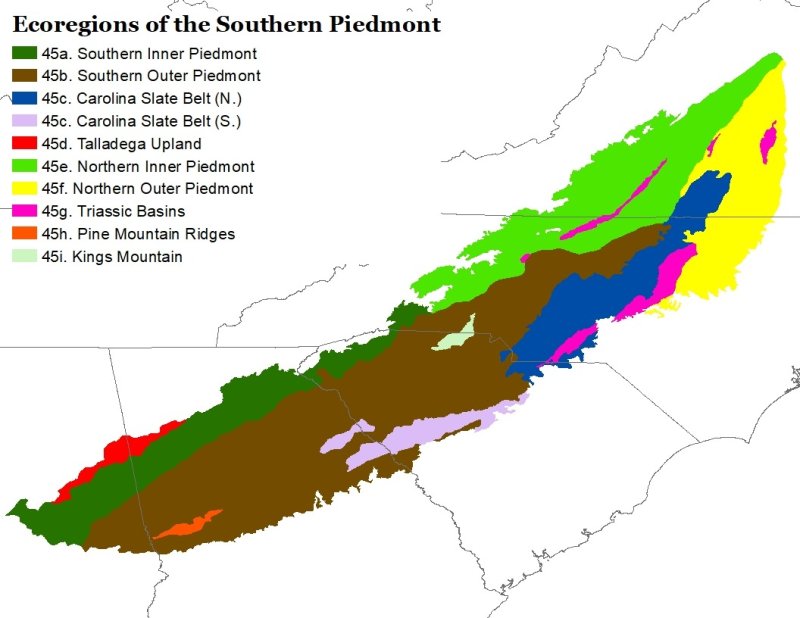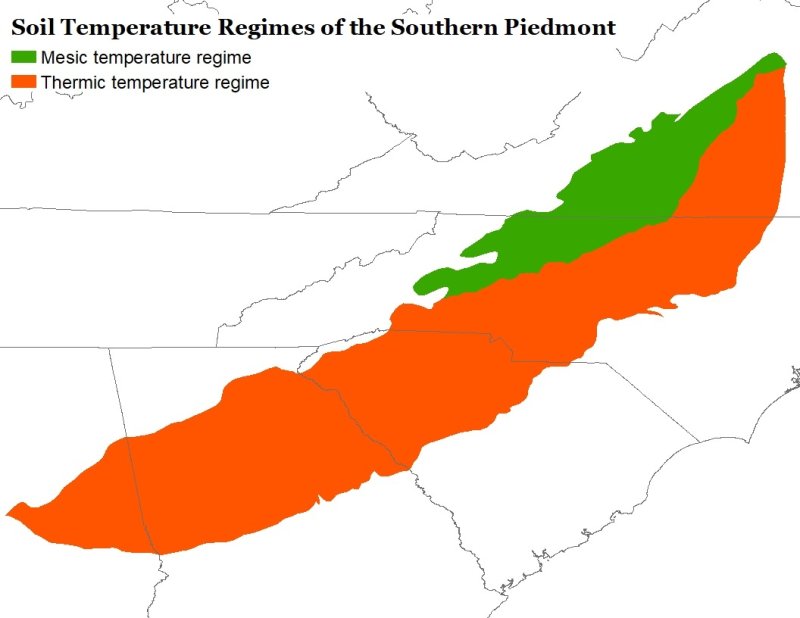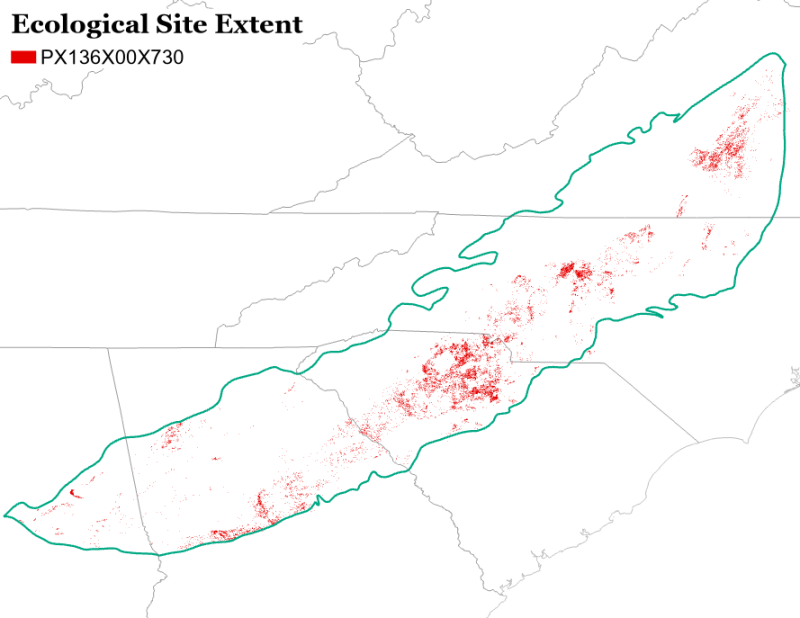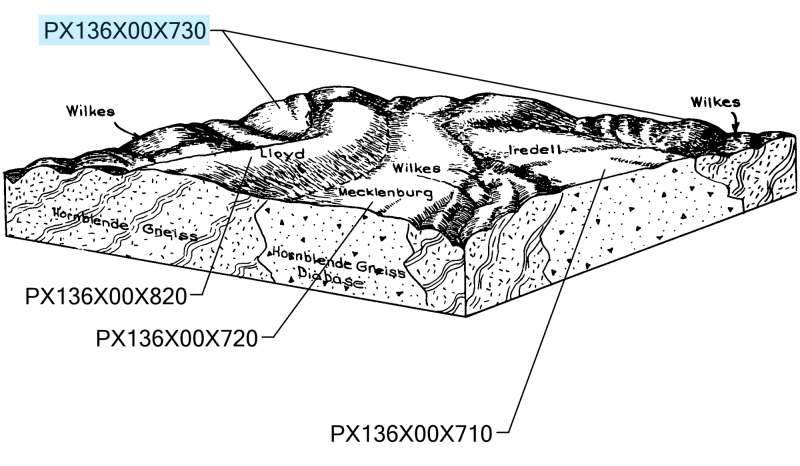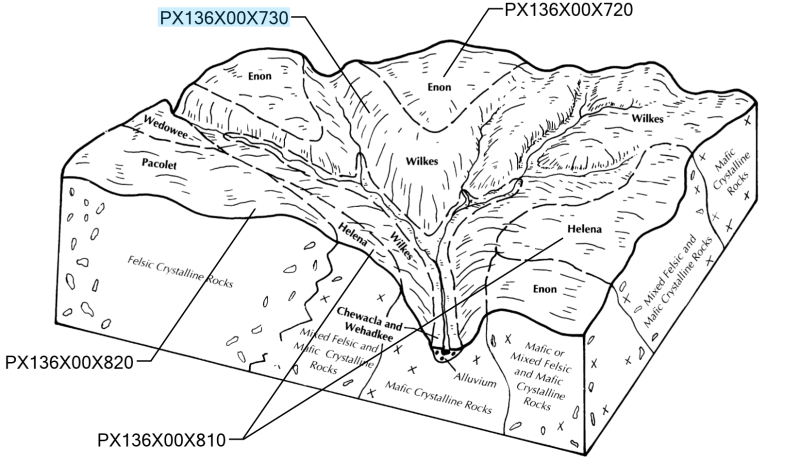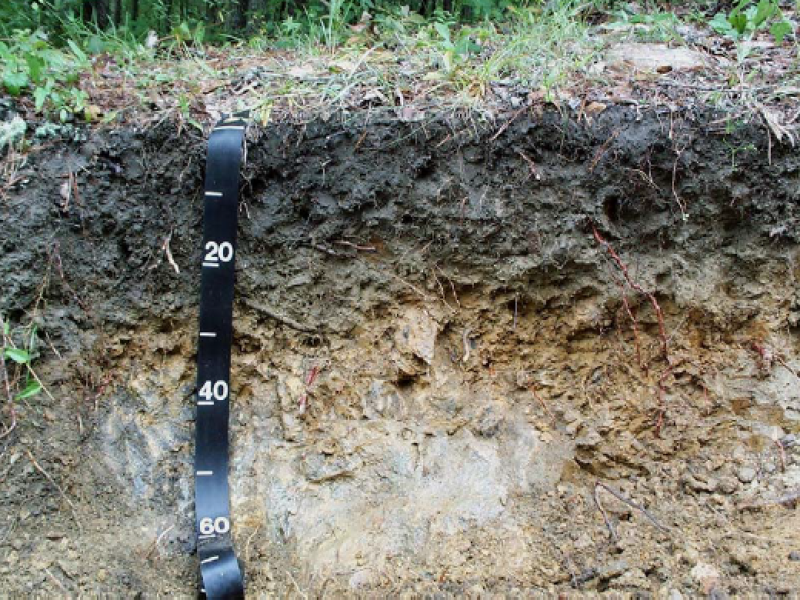Ecological dynamics
U.S. National Vegetation Classification (USNVC) associations that are consistent with reference conditions on this ecological site include CEGL007773 Quercus alba - Quercus stellata - Carya carolinae-septentrionalis / Acer leucoderme - Cercis canadensis. On high hills of the upper Piedmont and Carolina Slate Belt, CEGL004416 Quercus montana - Quercus stellata - Carya glabra / Vaccinium arboreum - Viburnum rufidulum may apply in some stands. Where the substrate thins and rock outcrops become more abundant, usually on steep slopes, CEGL004443 Juniperus virginiana - Ulmus alata / Schizachyrium scoparium, or other associations dominated by eastern redcedar may apply to small patches (USNVC 2022).
MATURE FORESTS
The reference state supports a partially open to closed canopy oak-hickory forest, with a higher proportion of hickories, elms, and ashes, and greater species diversity than is typical of similar acidic forest types. Acid-loving flora are usually scarce or absent in the understory and basic indicator species are typically present in greater numbers.
In the canopy layer, the oak component includes a higher proportion of dry-site oaks than is typical of moister sites, including post oak (Quercus stellata), black oak (Quercus velutina), and southern red oak (Quercus falcata), along with somewhat more mesophytic species such as white oak (Quercus alba), and several species of hickory (Carya carolinae-septentrionalis, C. tomentosa, C. glabra, C. ovalis). Mesophytic oaks less drought-tolerant than white oak (Q. alba) (e.g., northern red oak (Quercus rubra)), are generally absent or scarce.
In mature stands, pines are typically scattered throughout the forest. Loblolly pine (Pinus taeda) and shortleaf pine (P. echinata) are the principle species in most of the thermic soil temperature regime portion of the MLRA. According to historical accounts and witness tree records, the importance of the pine component naturally increases, though very gradually, from north to south. Shortleaf pine likely dominated the pine component in the past, though loblolly is of equal or greater importance in contemporary stands. Prior to the European settlement, loblolly pine was largely confined to drainageways and adjacent lower slopes in the uplands of the Southern Piedmont.
In the reference state, the subcanopy layer includes basic indicator species such as eastern redbud (Cercis canadensis), eastern redcedar (Juniperus virginiana), chalk maple (Acer leucoderme), white fringetree (Chionanthus virginicus), white ash (Fraxinus americana), and dwarf hackberry (Celtis pumila). Subcanopy generalists include flowering dogwood (Cornus florida), red maple (Acer rubrum), and American persimmon (Diospyros virginiana), along with saplings of canopy species.
Species typical of the shrub layer include rusty blackhaw (Viburnum rufidulum), mapleleaf viburnum (Viburnum acerifolium), downy arrowwood (Viburnum rafinesqueanum), and coralberry (Symphoricarpos orbiculatus). Other shrub species which are characteristic, but generally of low cover include Fragrant sumac (Rhus aromatica), hog plum (Prunus umbellata), and smallflower pawpaw (Asimina parviflora). Several species of blueberry (Vaccinium spp.) may be present, but they typically are of low cover. Of the Vaccinium species, farkleberry (Vaccinium arboreum) is most common on this ecological site, as it is tolerant of both acidic and circumneutral conditions.
In the herb layer, characteristic grasses and grass-like plants include blackseed speargrass (Piptochaetium avenaceum), little bluestem (Schizachyrium scoparium), poverty oatgrass (Danthonia spicata), and littlehead nutrush (Scleria oligantha). Common forbs include anisescented goldenrod (Solidago odora), wreath goldenrod (Solidago caesia), wild quinine (Parthenium integrifolium), and rattlesnakeweed (Hieracium venosum). Basic indicator species typical of the herb layer including nettleleaf sage (Salvia urticifolia), nettleleaf noseburn (Tragia urticifolia), whorled milkweed (Asclepias verticillata), and many others.
DYNAMICS OF NATURAL SUCCESSION AND FIRE ECOLOGY
On Piedmont uplands, the historical influence of fire on successional dynamics was likely expressed on a continuum, from dry to moist, where moist or sheltered sites were shaped more by gap-driven dynamics and dry or exposed sites more by fire. On intermediate sites, such as those associated with this ecological site, their respective influence on successional dynamics probably fell somewhere in between. While the historic fire return interval is thought to be relatively similar across most of the Southern Piedmont uplands, drier sites were more prone to fire and hence burned more completely and at higher intensities than moister sites.
Like other oak-hickory forests in the region, small-scale natural disturbances such as windthrow, drought, and disease, are important drivers of natural succession in contemporary stands. Presumably these localized events made a rather large contribution to the disturbance regime in the past, though fire likely had shared influence in shaping the competitive environment for plants on this ecological site.
In the past, regular low-intensity fires would have kept the understory somewhat more open than at present and constrained the growth of fire-intolerant woody species. Periodic severe fires would have likely occurred during unusually dry and windy conditions, presumably resulting in catastrophic tree mortality and stand replacing changes. The reduction in the frequency of fires over the past century has allowed shade-tolerant, fire-sensitive trees such as red maple (Acer rubrum), American beech (Fagus grandifolia), and American holly (Ilex opaca) to become more abundant in many upland forests in the Southeast.
A combination of prescribed burns and selective removals can open up the understory and constrain the growth of fire-intolerant opportunistic species, thereby restoring the health and vigor of forests that evolved under a more regular fire regime.
YOUNG SECONDARY FORESTS
On relatively undisturbed sites, stands are uneven-aged, with at least some old trees present. In areas that were cultivated in the recent past, even-aged pine stands dominate the landscape, being replaced by oaks and hickories only as the pines die.
In general, young secondary forests on this ecological site are dominated by loblolly and shortleaf pines, along with opportunistic hardwoods such as sweetgum (Liquidambar styraciflua) and red maple (Acer rubrum). Oaks and hickories, including white oak (Q. alba), post oak (Q. stellata), and black oak (Q. velutina), along with hickories (Carya spp.), are usually confined to the understory of young secondary stands. Their growth is temporarily suppressed by the cover of faster growing tree species.
In the central Piedmont of North Carolina and Virginia, Virginia pine (P. virginiana) becomes increasingly important in young secondary stands, particularly in the Carolina Slate Belt and even more so in regions to the west or north. In regions further south, loblolly pine is typically the more competitive pioneer under most site conditions, apart from higher elevation areas of the upper Piedmont where Virginia pine becomes more abundant (Wharton 1978; Barry 1980; Peet and Christensen 1980, 1987; Nelson 1986; Schafale and Weakley 1990; Cowell 1998; Spira 2011; Fleming 2012; Guyette et al. 2012; Schafale 2012a, 2012b; Edwards et al. 2013; Vander Yacht et al. 2020; Fleming et al. 2021; Greenberg et al. 2021; Spooner et al. 2021).
.
SPECIES LIST
Canopy layer: Quercus alba, Quercus stellata, Quercus velutina, Quercus falcata, Carya carolinae-septentrionalis, Carya tomentosa, Carya glabra, Carya ovalis, Quercus marilandica, Quercus montana, Carya pallida, Pinus echinata, Pinus virginiana, Ulmus alata, Quercus muehlenbergii,
Subcanopy layer: Acer leucoderme, Cercis canadensis, Juniperus virginiana, Cornus florida, Acer rubrum, Chionanthus virginicus, Fraxinus americana, Carya spp., Celtis pumila, Acer floridanum, Diospyros virginiana, Ulmus alata,
Vines/lianas: Vitis rotundifolia, Smilax glauca, Smilax bona-nox, Matelea decipiens, Cocculus carolinus, Lonicera japonica (I)
Shrub layer: Viburnum rufidulum, Viburnum acerifolium, Viburnum rafinesqueanum, Vaccinium arboreum, Symphoricarpos orbiculatus, Hypericum hypericoides ssp. multicaule, Crataegus uniflora, Ceanothus americanus, Rhus aromatica, Prunus umbellata, Asimina parviflora, Styrax grandifolius, Physocarpus opulifolius, Ptelea trifoliata
Herb layer - forbs: Desmodium spp., Solidago odora, Solidago caesia, Parthenium integrifolium, Hieracium venosum, Coreopsis major, Clitoria mariana, Asplenium platyneuron, Salvia urticifolia, Tragia urticifolia, Asclepias verticillata, Eryngium yuccifolium var. yuccifolium, Hieracium gronovii, Helianthus divaricatus, Hypoxis hirsuta, Silphium compositum, Liatris squarrosa, Asclepias viridiflora, Coreopsis verticillata, Saxifraga virginiensis, Euphorbia pubentissima, Euphorbia corollata, Delphinium spp., Trifolium reflexum, Myriopteris tomentosa, Myriopteris lanosa, Pleopeltis polypodioides ssp. michauxiana, Uvularia perfoliata, Ionactis linariifolius, Commelina erecta, Oligoneuron album, Ruellia purshiana, Antennaria plantaginifolia, Hypericum gentianoides, Agrimonia pubescens, Taenidia integerrima, Aquilegia canadensis, Angelica venenosa, Arabis canadensis, Triosteum angustifolium
Herb layer - graminoids: Danthonia spicata, Danthonia sericea, Schizachyrium scoparium, Piptochaetium avenaceum, Scleria oligantha, Dichanthelium depauperatum, Dichanthelium dichotomum var. dichotomum, Dichanthelium boscii, Carex spp. (rosea, striatula, retroflexa), Andropogon ternarius, Panicum spp., Melica mutica, Muhlenbergia capillaris, Sporobolus junceus
(I) = introduced
State 1
Reference State
This mature forest state supports an oak-hickory forest with a greater proportion of dry-site oaks than is typical of moister oak-hickory forest types. It usually has a greater proportion of hickories, elms, and ashes than acidic oak-hickory forest types.
Characteristics and indicators. Stands are uneven-aged with at least some old trees present. Pines make up a minority of the canopy cover.
Resilience management. Deer population management is critical to sustaining the diversity of herbaceous understory species.
Community 1.1
Dry Basic Oak-Hickory Forest - Fire Maintained Phase
This is a mature forest community/phase with a partially open canopy. Regular low-intensity fires have been reintroduced, keeping the understory open, increasing the cover and diversity of herbaceous species and limiting the importance of fire-intolerant woody species.
Resilience management. This community/phase is maintained through regular prescribed burns. The recruitment of fire-adapted oaks and pines benefits from regular low-intensity ground fires, as these forests evolved under a more regular fire regime. Tree ring data suggests that the mean fire return interval of the past in the Southern Piedmont is approximately 6 years, though the actual return interval varied from 3 to 16 years. To approximate the pre-colonial fire regime, prescribed burns should be carried out every 4 to 8 years.
Forest overstory. The overstory is dominated by oaks. Representative species include white oak (Quercus alba), post oak (Quercus stellata), and black oak (Quercus velutina), with a smaller but significant contribution from hickories. Pines are typically scattered throughout the forest. Characteristic hickory species include southern shagbark hickory (Carya carolinae-septentrionalis), mockernut hickory (Carya tomentosa), pignut hickory (Carya glabra), and red hickory (C. ovalis). Shortleaf pine (Pinus echinata) is representative of the pine component.
Forest understory. Representative understory tree species include eastern redbud (Cercis canadensis), eastern redcedar (Juniperus virginiana), flowering dogwood (Cornus florida), white fringetree (Chionanthus virginicus), hickory (Carya spp.), dwarf hackberry (Celtis pumila), and chalk maple (Acer leucoderme).
Representative understory shrub species include rusty blackhaw (Viburnum rufidulum), mapleleaf viburnum (Viburnum acerifolium), downy arrowwood (Viburnum rafinesqueanum), several species of blackberry (Rubus spp.), coralberry (Symphoricarpos orbiculatus), and farkleberry (Vaccinium arboreum), among others.
The herb layer is denser overall and contains more grasses than in the fire suppressed phase.
Dominant plant species
-
white oak (Quercus alba), tree
-
post oak (Quercus stellata), tree
-
black oak (Quercus velutina), tree
-
mockernut hickory (Carya tomentosa), tree
-
shortleaf pine (Pinus echinata), tree
-
eastern redbud (Cercis canadensis), tree
-
eastern redcedar (Juniperus virginiana), tree
-
flowering dogwood (Cornus florida), tree
-
white fringetree (Chionanthus virginicus), tree
-
chalk maple (Acer leucoderme), tree
-
rusty blackhaw (Viburnum rufidulum), shrub
-
mapleleaf viburnum (Viburnum acerifolium), shrub
-
downy arrowwood (Viburnum rafinesqueanum), shrub
-
blackberry (Rubus), shrub
-
farkleberry (Vaccinium arboreum), shrub
-
coralberry (Symphoricarpos orbiculatus), shrub
-
St. Andrew's cross (Hypericum hypericoides ssp. multicaule), shrub
-
poverty oatgrass (Danthonia spicata), grass
-
downy danthonia (Danthonia sericea), grass
-
little bluestem (Schizachyrium scoparium), grass
-
blackseed speargrass (Piptochaetium avenaceum), grass
-
littlehead nutrush (Scleria oligantha), grass
-
starved panicgrass (Dichanthelium depauperatum), grass
-
cypress panicgrass (Dichanthelium dichotomum var. dichotomum), grass
-
Bosc's panicgrass (Dichanthelium boscii), grass
-
rosy sedge (Carex rosea), grass
-
lined sedge (Carex striatula), grass
-
anisescented goldenrod (Solidago odora), other herbaceous
-
wreath goldenrod (Solidago caesia), other herbaceous
-
rattlesnakeweed (Hieracium venosum), other herbaceous
-
wild quinine (Parthenium integrifolium), other herbaceous
-
ticktrefoil (Desmodium), other herbaceous
-
lespedeza (Lespedeza), other herbaceous
-
greater tickseed (Coreopsis major), other herbaceous
-
Atlantic pigeonwings (Clitoria mariana), other herbaceous
-
nettleleaf sage (Salvia urticifolia), other herbaceous
-
nettleleaf noseburn (Tragia urticifolia), other herbaceous
Community 1.2
Dry Basic Oak-Hickory Forest - Fire Suppressed Phase
This is a closed canopy mature forest community/phase. This phase accounts for the majority of contemporary examples. Canopy cover is higher than in stands in which fire has been reintroduced. The pine component can have a greater proportion of loblolly or Virginia pine and the understory usually contains a greater proportion of fire-intolerant species. The herbaceous understory is typically sparse.
Forest overstory. The overstory is dominated by oaks. Representative species include white oak (Quercus alba), post oak (Quercus stellata), and black oak (Quercus velutina), with a smaller but significant contribution from hickories. Pines, including Virginia pine (Pinus virginiana) and shortleaf pine (Pinus echinata), are typically scattered throughout the forest.Characteristic hickory species include southern shagbark hickory (Carya carolinae-septentrionalis), mockernut hickory (Carya tomentosa), pignut hickory (Carya glabra), and red hickory (Carya ovalis). Loblolly pine (Pinus taeda) and shortleaf pine (Pinus echinata) are most representative of the pine component. In portions of the MLRA, Virginia pine (Pinus virginiana) can be equally important in fire suppressed stands.
Forest understory. Representative understory tree species include chalk maple (Acer leucoderme), eastern redbud (Cercis canadensis), eastern redcedar (Juniperus virginiana), red maple (Acer rubrum), white ash (Fraxinus americana), American beech (Fagus grandifolia), flowering dogwood (Cornus florida), white fringetree (Chionanthus virginicus), and hickory (Carya spp.).
Representative understory shrub species include rusty blackhaw (Viburnum rufidulum), mapleleaf viburnum (Viburnum acerifolium), downy arrowwood (Viburnum rafinesqueanum), farkleberry (Vaccinium arboreum), and coralberry (Symphoricarpos orbiculatus), among others.
The herb layer is sparser overall and is less grassy than in the fire maintained phase.
Dominant plant species
-
white oak (Quercus alba), tree
-
post oak (Quercus stellata), tree
-
black oak (Quercus velutina), tree
-
mockernut hickory (Carya tomentosa), tree
-
loblolly pine (Pinus taeda), tree
-
chalk maple (Acer leucoderme), tree
-
eastern redbud (Cercis canadensis), tree
-
red maple (Acer rubrum), tree
-
eastern redcedar (Juniperus virginiana), tree
-
white ash (Fraxinus americana), tree
-
American beech (Fagus grandifolia), tree
-
rusty blackhaw (Viburnum rufidulum), shrub
-
mapleleaf viburnum (Viburnum acerifolium), shrub
-
downy arrowwood (Viburnum rafinesqueanum), shrub
-
farkleberry (Vaccinium arboreum), shrub
-
muscadine (Vitis rotundifolia), shrub
-
cat greenbrier (Smilax glauca), shrub
-
coralberry (Symphoricarpos orbiculatus), shrub
-
rosette grass (Dichanthelium), grass
-
poverty oatgrass (Danthonia spicata), grass
-
downy danthonia (Danthonia sericea), grass
-
littlehead nutrush (Scleria oligantha), grass
-
ebony spleenwort (Asplenium platyneuron), other herbaceous
-
rattlesnakeweed (Hieracium venosum), other herbaceous
-
wreath goldenrod (Solidago caesia), other herbaceous
Pathway 1.1A
Community 1.1 to 1.2
Long-term exclusion of fire causes an increase in fire-intolerant understory species and a deterioration of the abundance and diversity of herbaceous species.
Pathway 1.2A
Community 1.2 to 1.1
The fire suppressed phase can be managed towards the fire maintained phase through a combination of prescribed burns and selective removals. To approximate the pre-colonial fire regime, prescribed burns should be carried out every 4 to 8 years.
Context dependence. After decades of fire suppression, most upland hardwood forests of the Southeast have undergone mesophication, or succession toward forest systems that are less apt to burn. If prescribed fire is to be used as a management tool in fire suppressed ecosystems of the Piedmont, planning will be needed in some forest systems to overcome the effects of mesophication in the early stages of fire reintroduction.
State 2
Secondary Succession State
This state develops in the immediate aftermath of agricultural abandonment, clearcut logging, or other large-scale disturbances that lead to canopy removal. Which species colonize a particular location in the wake of a disturbance does involve a considerable degree of chance. It also depends a great deal on the type, duration, and magnitude of the disturbance event.
Characteristics and indicators. Plant age distribution is even. Plants exhibit pioneering traits such as rapid growth, early reproduction, and shade-intolerance.
Community 2.1
Old-field Pine-Hardwood Forest Phase
This forested successional phase develops in the wake of long-term agricultural abandonment or other large-scale disturbances that have led to canopy removal in the recent past. Stands are even-aged and species diversity is low. The canopy is usually dominated by pines, though opportunistic hardwoods can also be important, particularly in the early stages of tree establishment. Species that exhibit pioneering traits are usually most abundant.
Forest overstory. The overstory is dominated by pines. Loblolly pine (Pinus taeda) is the most characteristic species, followed by shortleaf pine (P. echinata), and to the north and west Virginia pine (P. virginiana).
Forest understory. Common understory tree species include eastern redcedar (Juniperus virginiana), red maple (Acer rubrum), sweetgum (Liquidambar styraciflua), and Sassafras (Sassafras albidum). Seedlings of oaks and hickories are usually present in the understory. These seedlings are released gradually as the forest matures and the pines begin to die off.
Dominant plant species
-
loblolly pine (Pinus taeda), tree
-
Virginia pine (Pinus virginiana), tree
-
shortleaf pine (Pinus echinata), tree
-
eastern redcedar (Juniperus virginiana), tree
-
sweetgum (Liquidambar styraciflua), tree
-
red maple (Acer rubrum), tree
-
flowering dogwood (Cornus florida), tree
-
sassafras (Sassafras albidum), tree
-
southern red oak (Quercus falcata), tree
-
mockernut hickory (Carya tomentosa), tree
-
muscadine (Vitis rotundifolia), shrub
-
Japanese honeysuckle (Lonicera japonica), shrub
-
greenbrier (Smilax), shrub
-
blueberry (Vaccinium), shrub
-
rosette grass (Dichanthelium), grass
-
littlehead nutrush (Scleria oligantha), grass
-
poverty oatgrass (Danthonia spicata), grass
-
ebony spleenwort (Asplenium platyneuron), other herbaceous
Community 2.2
Shrub-dominated Successional Phase
This successional phase is dominated by shrubs and vines, along with seedlings of opportunistic hardwoods and pines. It typically develops beginning in the third year after agricultural abandonment or clearcut logging. It grades into the forested successional phase as tree seedlings become saplings and begin to occupy more of the canopy cover.
Forest overstory. Species composition varies considerably from location to location.
Dominant plant species
-
loblolly pine (Pinus taeda), tree
-
eastern redcedar (Juniperus virginiana), tree
-
winged elm (Ulmus alata), tree
-
Callery pear (Pyrus calleryana), tree
-
silktree (Albizia julibrissin), tree
-
Chinaberrytree (Melia azedarach), tree
-
blackberry (Rubus), shrub
-
rose (Rosa), shrub
-
Japanese honeysuckle (Lonicera japonica), shrub
-
greenbrier (Smilax), shrub
-
winged sumac (Rhus copallinum), shrub
-
coralberry (Symphoricarpos orbiculatus), shrub
-
sassafras (Sassafras albidum), shrub
-
smooth sumac (Rhus glabra), shrub
-
broomsedge bluestem (Andropogon virginicus), grass
-
dogfennel (Eupatorium capillifolium), other herbaceous
-
goldenrod (Solidago), other herbaceous
-
aster (Symphyotrichum), other herbaceous
-
sericea lespedeza (Lespedeza cuneata), other herbaceous
-
Indianhemp (Apocynum cannabinum), other herbaceous
Community 2.3
Herbaceous Early Successional Phase
This transient community is composed of the first herbaceous invaders in the aftermath of agricultural abandonment, clearcut logging, or other large-scale natural disturbances that lead to canopy removal.
Resilience management. If the user wishes to maintain this community/phase for wildlife or pollinator habitat, a prescribed burn, mowing, or prescribed grazing will be needed at least once annually to prevent community pathway 2.3A. To that end, as part of long-term maintenance, periodic overseeding of wildlife or pollinator seed mixtures can be helpful in ensuring the viability of certain desired species and maintaining the desired composition of species for user goals.
Dominant plant species
-
Japanese honeysuckle (Lonicera japonica), tree
-
evening trumpetflower (Gelsemium sempervirens), tree
-
greenbrier (Smilax), tree
-
broomsedge bluestem (Andropogon virginicus), grass
-
crabgrass (Digitaria), grass
-
dogfennel (Eupatorium capillifolium), other herbaceous
-
Canadian horseweed (Conyza canadensis), other herbaceous
-
goldenrod (Solidago), other herbaceous
-
Virginia dwarfdandelion (Krigia virginica), other herbaceous
-
Indianhemp (Apocynum cannabinum), other herbaceous
-
fleabane (Erigeron), other herbaceous
-
dwarf cinquefoil (Potentilla canadensis), other herbaceous
-
sericea lespedeza (Lespedeza cuneata), other herbaceous
-
cudweed (Pseudognaphalium), other herbaceous
-
Virginia threeseed mercury (Acalypha virginica), other herbaceous
Pathway 2.1A
Community 2.1 to 2.3
The old-field pine-hardwood forest phase can return to the herbaceous early successional phase through clearcut logging or other large-scale disturbances that cause canopy removal.
Context dependence. Note: if the user wishes to use this community pathway to create wildlife or pollinator habitat, please contact a local NRCS office for a species list specific to the area of interest and user needs.
Pathway 2.2A
Community 2.2 to 2.1
The shrub-dominated successional phase naturally moves towards the old-field pine-hardwood forest through natural succession.
Pathway 2.2B
Community 2.2 to 2.3
The shrub-dominated successional phase can return to the herbaceous early successional phase through brush management, including herbicide application, mechanical removal, prescribed grazing, or fire.
Context dependence. Note: if the user wishes to use this community pathway to create wildlife or pollinator habitat, please contact a local NRCS office for a species list specific to the area of interest and user needs.
If the user wishes to maintain the shrub-dominated successional phase long term, for wildlife habitat or other uses, periodic use of this community pathway is necessary to prevent community pathway 2.2A, which happens inevitably unless natural succession is set back through disturbance.
Pathway 2.3A
Community 2.3 to 2.2
The herbaceous early successional phase naturally moves towards the shrub-dominated successional phase through natural succession. The process takes approximately 3 years on average, barring any major disturbances capable of inhibiting natural succession.
State 3
High-graded Hardwood Forest State
This state develops as a consequence of high-grading, where the most valuable trees are removed, leaving less desirable timber specimens behind. Trees left behind include undesirable timber species, trees of poor form, diseased trees, or genetically inferior trees.
Characteristics and indicators. Typically, high-graded stands consist of a combination of residual stems from the previous stand, a high proportion of undesirable shade-tolerant species, along with some regrowth from desirable timber species. In some cases, large-diameter trees of desirable timber species may be present, but upon closer inspection, these trees usually have serious defects that resulted in their being left behind in earlier cuts.
Resilience management. Landowners with high-graded stands have two options for improving timber production: 1) rehabilitate, or 2) regenerate. To rehabilitate a stand, the landowner must evaluate existing trees to determine if rehabilitation is justified. If the proportion of high-quality specimens present in the stand is low, then the stand should be regenerated. In many cases, poor quality of the existing stand is the result of decades of mismanagement. Drastic measures are often required to get the stand back into good timber production.
State 4
Managed Pine Plantation State
This converted state is dominated by planted timber trees. Loblolly pine (Pinus taeda) is the most commonly planted species. Even-aged management is the most common timber management system.
Note: if the user wishes to convert stands dominated by hardwoods to planted pine, clearcutting will usually be necessary first, allowing herbaceous pioneers to establish on the site in the weeks or months prior to planting. Users should utilize measures described in transition T2B under these circumstances.
Resilience management. Hardwood Encroachment:
Hardwood encroachment can be problematic in managed pine plantations. Good site preparation, proper stocking, and periodic thinning are advisable to reduce hardwood competition.
Overstocking:
The overstocked condition commonly occurs in naturally regenerated stands. When competition from other pines begins to impact the health and productivity of the stand, precommercial thinning should be considered. At this point, the benefit of thinning usually outweighs the potential for invasion and competition from non-pine species. As the target window for thinning passes, the condition of the stand can slowly deteriorate if no action is taken. Under long-term overstocked conditions, trees are more prone to stresses, including pine bark beetle infestation and damage from wind or ice.
High-grading:
In subsequent commercial thinnings, care should be taken in tree selection. High quality specimens should be left to reach maturity, while slower growing trees or those with defects should be removed sooner. If high quality specimens are harvested first, trees left behind are often structurally unsound, diseased, genetically inferior, or of poor form. This can have long-term implications for tree genetics and for the condition of the stand (Felix III 1983; Miller et al. 1995, 2003; Megalos 2019).
Dominant plant species
-
loblolly pine (Pinus taeda), tree
-
sweetgum (Liquidambar styraciflua), tree
-
eastern redcedar (Juniperus virginiana), tree
-
red maple (Acer rubrum), tree
-
eastern redbud (Cercis canadensis), tree
-
sassafras (Sassafras albidum), tree
-
oak (Quercus), tree
-
hybrid hickory (Carya), tree
-
grape (Vitis), shrub
-
Japanese honeysuckle (Lonicera japonica), shrub
-
greenbrier (Smilax), shrub
-
blackberry (Rubus), shrub
-
St. Johnswort (Hypericum), shrub
-
blueberry (Vaccinium), shrub
-
rosette grass (Dichanthelium), grass
-
littlehead nutrush (Scleria oligantha), grass
-
poverty oatgrass (Danthonia spicata), grass
-
broomsedge bluestem (Andropogon virginicus), grass
-
silver plumegrass (Saccharum alopecuroides), grass
-
ebony spleenwort (Asplenium platyneuron), other herbaceous
-
aster (Symphyotrichum), other herbaceous
-
thoroughwort (Eupatorium), other herbaceous
-
dwarf cinquefoil (Potentilla canadensis), other herbaceous
State 5
Pasture/Hayland State
This converted state is dominated by herbaceous forage species.
Resilience management. Overgrazing and High Foot Traffic:
In areas that are subject to high foot traffic from livestock and equipment, and/or long-term overgrazing, unpalatable weedy species tend to invade, as most desirable forage species are less competitive under these conditions. High risk areas include locations where livestock congregate for water, shade, or feed, and in travel lanes, gates, and other areas of heavy use. Plant species that are indicative of overgrazing or excessive foot traffic on this ecological site include buttercup (Ranunculus spp.), plantain (Plantago spp.), curly dock (Rumex crispus), sneezeweed (Helenium amarum), cudweed (Pseudognaphalium spp.), slender yellow woodsorrel (Oxalis dillenii), Carolina horsenettle (Solanum carolinense), Virginia pepperweed (Lepidium virginicum), black medick (Medicago lupulina), Japanese clover (Kummerowia striata), annual bluegrass (Poa annua), poverty rush (Juncus tenuis), rattail fescue (Vulpia myuros), and Indian goosegrass (Eleusine indica), among others. A handful of desirable forage species are also tolerant of heavy grazing and high foot traffic, including white clover (Trifolium repens), dallisgrass (Paspalum dilatatum), and bermudagrass (Cynodon dactylon). An overabundance of these species, along with poor plant vigor and areas of bare soil, may imply that excessive foot traffic and/or overgrazing is a concern, either in the present or in the recent past.
Brush Encroachment:
Brush encroachment can be problematic in some pastures, particularly near fence lines where there is often a ready seed source. Pastures subject to low stocking density and long-duration grazing rotations can also be susceptible to encroachment from woody plants. Shorter grazing rotations of higher stocking density can help alleviate pressure from shrubs and vines with low palatability or thorny stems. Clipping behind grazing rotations, annual brush hogging, and multispecies grazing systems (cattle with or followed by goats) can also be helpful. Common woody invaders of pasture on this ecological site include rose (Rosa spp.), blackberry (Rubus spp.), saw greenbrier (Smilax bona-nox), Japanese honeysuckle (Lonicera japonica), common persimmon (Diospyros virginiana), eastern redcedar (Juniperus virginiana), and black cherry (Prunus serotina).
Dominant plant species
-
Bermudagrass (Cynodon dactylon), grass
-
tall fescue (Schedonorus arundinaceus), grass
-
dallisgrass (Paspalum dilatatum), grass
-
hairy crabgrass (Digitaria sanguinalis), grass
-
purpletop tridens (Tridens flavus), grass
-
Johnsongrass (Sorghum halepense), grass
-
bahiagrass (Paspalum notatum), grass
-
broomsedge bluestem (Andropogon virginicus), grass
-
white clover (Trifolium repens), other herbaceous
-
vetch (Vicia), other herbaceous
-
narrowleaf plantain (Plantago lanceolata), other herbaceous
-
dogfennel (Eupatorium capillifolium), other herbaceous
-
black medick (Medicago lupulina), other herbaceous
-
field clover (Trifolium campestre), other herbaceous
-
common dandelion (Taraxacum officinale), other herbaceous
State 6
Cropland State
This converted state produces food or fiber for human uses. It is dominated by domesticated crop species, along with typical weedy invaders of cropland.
Community 6.1
Conservation-management Cropland Phase
This cropland phase is characterized by the practice of no-tillage or strip-tillage, and other soil conservation practices. Though no-till systems offer many benefits, several weedy species tend to be more problematic under this type of management system. In contrast with conventional tillage systems, problematic species in no-till systems include biennial or perennial weeds, owing to the fact that tillage is no longer used in weed management.
Community 6.2
Conventional-management Cropland Phase
This cropland phase is characterized by the recurrent use of tillage as a management tool. Due to the frequent disturbance regime, weedy invaders tend to be annual herbaceous species that reproduce quickly and are prolific seed producers.
Resilience management. The potential for soil loss is high under this management system. Measures should be put in place to limit erosion.
Pathway 6.1A
Community 6.1 to 6.2
The conservation-management cropland phase can shift to the conventional-management cropland phase through cessation of conservation tillage practices and the reintroduction of conventional tillage practices.
Context dependence. Soil and vegetation changes associated with this community pathway typically occur several years after reintroduction of conventional tillage practices. These changes continue to manifest as conventional tillage is continued, before reaching a steady state.
Pathway 6.2A
Community 6.2 to 6.1
The conventional-management cropland phase can be brought into the conservation-management cropland phase through the implementation of one of several conservation tillage options, including no-tillage or strip-tillage, along with implementation of other soil conservation practices.
Context dependence. Soil and vegetation changes associated with this community pathway typically occur several years after implementation of conservation tillage. These changes continue to manifest as conservation tillage is continued, before reaching a steady state.
Transition T1A
State 1 to 2
The reference state can transition to the secondary succession state through clearcut logging or other large-scale disturbances that cause canopy removal.
Transition T1B
State 1 to 3
The reference state can transition to the high-graded hardwood forest state through selective removal of the most valuable trees, leaving undesirable timber specimens behind. This may occur through multiple cutting cycles over the course of decades or longer, each cut progressively worsening the condition of the stand.
Transition T1C
State 1 to 5
The reference state can transition to the pasture/hayland state through 1) mechanical tree/brush/stump/debris removal, 2) seedbed preparation, and 3) planting of perennial grasses and forbs.
Context dependence. Herbicide applications, fire, and/or root-raking can be helpful in transitioning treed land to pasture. This is done in part to limit coppicing, as many woody plants are capable of sprouting from residual plant structures left behind after clearing. Judicious use of root-raking is recommended, as this practice can have long-term repercussions with regard to soil structure. Applications of fertilizer and lime can also be helpful in establishing perennial forage species. Grazing should be deferred until grasses and forbs are well established.
Transition T1D
State 1 to 6
The reference state can transition to the cropland state through 1) mechanical tree/brush/stump/debris removal, 2) seedbed preparation, 3) applications of fertilizer/lime, and 4) planting of crop or cover crop seed.
Context dependence. A broad spectrum herbicide, fire, and/or root-raking can be helpful in transitioning treed land to cropland. This is done in part to limit coppicing, as many woody plants are capable of sprouting from residual plant structures left behind after clearing. Judicious use of root-raking is recommended, as this practice can have long-term repercussions with regard to soil structure. Weedy grasses and forbs can also be problematic on these lands.
Transition T2A
State 2 to 1
The secondary succession state can transition to the reference state through long-term natural succession. This process can be accelerated to some degree by a combination of prescribed burns and selective harvesting of pines and opportunistic hardwoods.
Transition T2B
State 2 to 4
The secondary succession state can transition to the managed pine plantation state through site preparation and planting of timber trees. Thinning alone may be sufficient for portions of the forest if pines have already established, though it is rarely sufficient for an entire forest patch.
Transition T2C
State 2 to 5
The secondary succession state can transition to the pasture/hayland state through through 1) mechanical tree/brush/stump/debris removal, 2) seedbed preparation, and 3) planting of perennial grasses and forbs.
Context dependence. A broad spectrum herbicide, fire, and/or root-raking can be helpful in transitioning wooded or semi-wooded land to pasture. This is done in part to limit coppicing, as many woody pioneers are capable of sprouting from residual plant structures left behind after clearing. Judicious use of root-raking is recommended, as this practice can have long-term repercussions with regard to soil structure. Applications of fertilizer and lime can also be helpful in establishing perennial forage species. Grazing should be deferred until grasses and forbs are well established.
Transition T2D
State 2 to 6
The secondary succession state can transition to the cropland state through 1) mechanical tree/brush/stump/debris removal, 2) seedbed preparation, 3) applications of fertilizer/lime, 4) weed control, 5) planting of crop or cover crop seed.
Context dependence. A broad spectrum herbicide, fire, and/or root-raking may be needed to successfully transition land that has been fallow for some time back to cropland. This is done in part to limit coppicing, as many woody pioneers are capable of sprouting from residual plant structures left behind after clearing. Judicious use of root-raking is recommended, as this practice can have long-term repercussions with regard to soil structure. Weedy grasses and forbs can also be problematic on these lands.
Transition T3A
State 3 to 2
The high-graded hardwood forest state can transition to the secondary succession state through clearcut logging or other large-scale disturbances that cause canopy removal.
Transition T3C
State 3 to 5
The high-graded hardwood forest state can transition to the pasture/hayland state through 1) mechanical tree/brush/stump/debris removal, 2) seedbed preparation, and 3) planting of perennial grasses and forbs.
Context dependence. Herbicide applications, fire, and/or root-raking can be helpful in transitioning treed land to pasture. This is done in part to limit coppicing, as many woody plants are capable of sprouting from residual plant structures left behind after clearing. Judicious use of root-raking is recommended, as this practice can have long-term repercussions with regard to soil structure. Applications of fertilizer and lime can also be helpful in establishing perennial forage species. Grazing should be deferred until grasses and forbs are well established.
Transition T3D
State 3 to 6
The high-graded hardwood forest state can transition to the cropland state through 1) mechanical tree/brush/stump/debris removal, 2) seedbed preparation, 3) applications of fertilizer/lime, 4) weed control, 5) planting of crop or cover crop seed.
Context dependence. A broad spectrum herbicide, fire, and/or root-raking can be helpful in transitioning treed land to cropland. This is done in part to limit coppicing, as many woody pioneers are capable of sprouting from residual plant structures left behind after clearing. Judicious use of root-raking is recommended, as this practice can have long-term repercussions with regard to soil structure. Weedy grasses and forbs can also be problematic on these lands.
Transition T4A
State 4 to 2
The managed pine plantation state can transition to the secondary succession state through abandonment of forestry practices (with or without timber tree harvest).
Transition T4B
State 4 to 5
The managed pine plantation state can transition to the pasture/hayland state through 1) timber harvest, 2) mechanical stump and debris removal, 3) seedbed preparation, 4) planting of perennial grasses and forbs.
Context dependence. Applications of fertilizer and lime can be helpful in establishing perennial forage species. Grazing should be deferred until grasses and forbs are well established.
Transition T4C
State 4 to 6
The managed pine plantation state can transition to the cropland state through 1) timber harvest, 2) mechanical stump and debris removal, 3) seedbed preparation, 4) applications of fertilizer/lime, 5) weed control, 6) planting of crop or cover crop seed.
Transition T5A
State 5 to 2
The pasture/hayland state can transition to the secondary succession state through long-term cessation of grazing.
Transition T5B
State 5 to 4
The pasture/hayland state can transition to the managed pine plantation state through site preparation and tree planting.
Transition T5C
State 5 to 6
The pasture/hayland state can transition to the cropland state through 1) seedbed preparation, 2) applications of fertilizer/lime, 3) weed control, and 4) planting of crop or cover crop seed.
Transition T6A
State 6 to 2
The cropland state can transition to the secondary succession state through agricultural abandonment.
Transition T6B
State 6 to 4
The cropland state can transition to the managed pine plantation state through site preparation and tree planting.
Transition T6C
State 6 to 5
The cropland state can transition to the pasture/hayland state through 1) seedbed preparation, 2) weed control, and 3) planting of perennial forage grasses and forbs.
Context dependence. To convert cropland to pasture or hayland, weed control and good seed-soil contact are important. It is also critical to review the labels of herbicides used for weed control and on the previous crop. Many herbicides have plant-back restrictions, which if not followed could carryover and kill forage seedlings as they germinate. Grazing should be deferred until grasses and forbs are well established.

